|
|
 |
Clark County Press, Neillsville, WI February 22, 1995, Page 36 Transcribed by Dolores (Mohr) Kenyon. Index of "Oldies" Articles
|
|
|
 |
Clark County Press, Neillsville, WI February 22, 1995, Page 36 Transcribed by Dolores (Mohr) Kenyon. Index of "Oldies" Articles
|
Good Old Days
By Dee Zimmerman
The various streams and the Black River that meander through Clark County make it necessary to have bridges at strategic placements to enable the uninterrupted movement of travel and transportation across the county.
In time, after years of traffic, each bridge structure eventually deteriorates and must be replaced. The old style overhead truss bridges are disappearing. The Lynch bridge also known as the Opelt bridge was one of those bridges to be removed. It spanned the Black River where Opelt Avenue and Bryan Avenue join in Levis Township. After being dismantled, it was sold and hauled to a western site to be erected on ranch land.
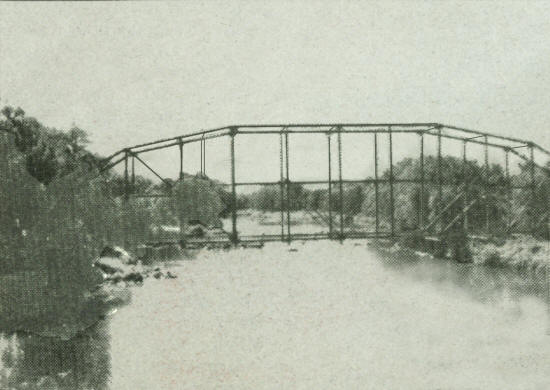 |
An overhead truss bride spanned the Black River in the Town of Levis, referred to as the Lynch or Opelt bridge and was dismantled in 1992.
A steel overhead bridge on North Grand Avenue spanned the Black River in the early 1900s. Tragedy struck in the summer of 1919 when it collapsed under the weight of three vehicles passing over it. Clark County trucks had been hauling shale from the pit on the northwest side of the bridge. Jack Verkuilen and John Gullickson, drivers of county trucks, slowed down their trucks as they met in the middle of the bridge and exchanged some conversation. Verkuilen’s truck stalled so he had to get out to crank the engine. At that moment Gullickson’s loaded truck crossed the weakened support that caused the bridge to collapse. The bridge settled to the bed of the river, but Gullickson’s truck remained upright and hung on the incline bank of the river. William Meihack was driving his passenger car across the bridge at that moment and his car was beside Verkuilen’s truck when the bridge collapsed. A large iron cross beam, fell across the hood of his car smashing it down. The beam missed striking Meihack by about a foot. Verkuilen was struck by a truss rod and then an iron support fell across his body, resulting in his death.
Henry Seidelman, another truck driver, came upon the scene trying to help Meihack and Gullickson in rescuing Verkuilen, but their efforts were futile.
Previous to the accident, the Town of Pine Valley and City of Neillsville had joined efforts in making repairs on the 240 ft. structure. With no supports under the center of the bridge, it was believed that the heavy traffic of the large shale loaded trucks gradually weakened it until it collapsed without any warning.
A new concrete bridge was built and opened for travel in 1920. For temporary use and convenience to the people living on the north side of the river, a temporary foot bridge was put up west of the fallen structure.
So now, 75 years later, the concrete bridge has weakened to the point of having to be replaced by a newer, stronger structure that will take over the needs of conveying traffic along Grand Avenue into the north countryside.
The 1920 concrete bridge did well, serving the community for three-quarters of a century.
There are three overhead truss bridges that remain in the county, still being useful; one in the town of Weston, one on the town line between Warner and Beaver townships and one on the west side of Greenwood, Highway “G.” A thru-truss bridge spans the Black River on Highway “H,” west of Christie.
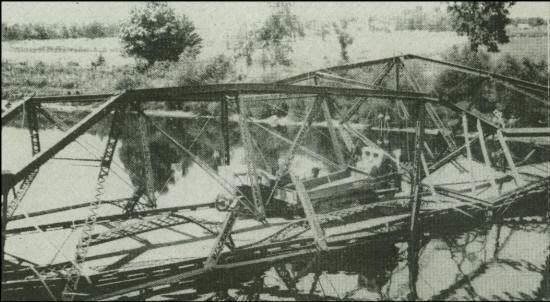 |
The Grand Avenue overhead truss bridge, on Neillsville’s northwest side, collapsed in the summer of 1919. A county truck driven by Jack Verkuilen, and the passenger car of William Meihack were at the center of the structure when it went down. Verkuilen died when struck by an iron crossbeam.
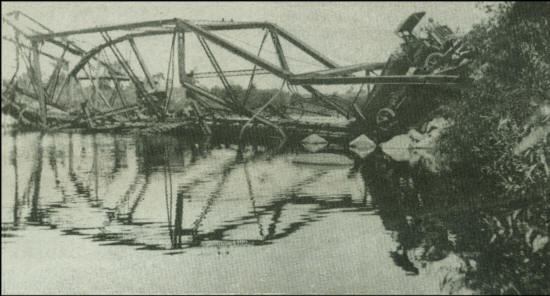 |
John Gullickson, driving a county truck loaded with shale, hung up on the river bank when the Grand Avenue Bridge fell to the river bed.
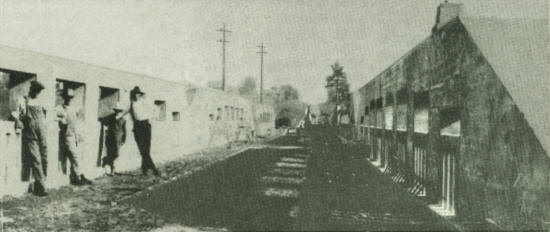 |
A view of the Grand Avenue concrete bridge on the day it was completed and opened for the traffic in 1920, serving the community for 75 years, until this month when it was demolished. Standing on the bridge, left to right: John Gullickson, Frank Anding, Art Gress (age 12) and Wm. Meihack.
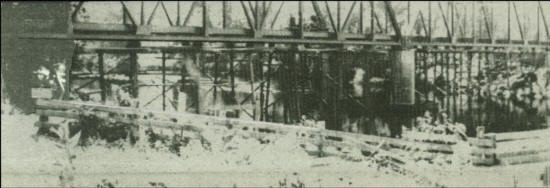 |
A 1938 photo of the truss bridge on Greenwood’s west side, as Highway “G” crosses the Black River. The bridge still carries traffic along that route.
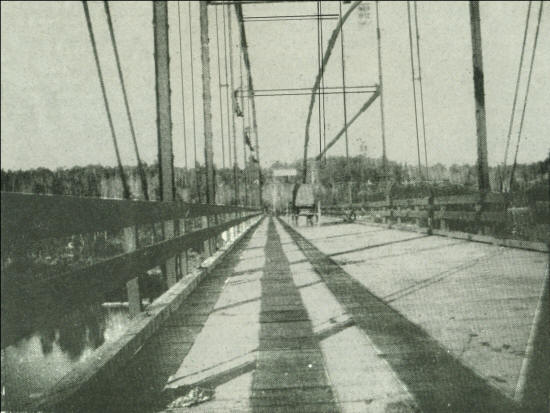 |
The East Weston Township overhead truss bridge was over Black River, west of Christie. A thru-truss bridge now spans the site on Highway “H.”
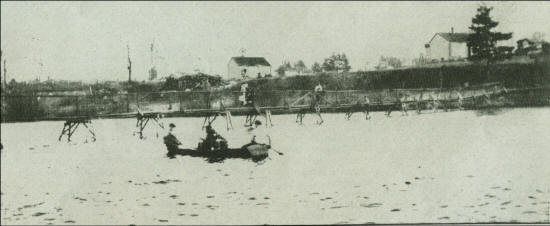 |
A temporary foot bridge was put up across Black River after the overhead bridge collapsed. It enabled people living on the north side of the river to get into the city while a new bridge was being erected. The Carl Gruebs and Alice Struble homes are visible in the background of the photo. Gertie (Gress) Hagedorn, a youngster at the time, was standing in the middle of the bridge. Carskaden boys were rowing their boat nearby.
(Thanks to Ruby Meihack for the 1919 news article, Gertie (Gress) Hagedorn, Bill Joyce, the Clark County Historical Society for the rare collection of photographs, and the Clark County Highway Departments office staff for their information.)
Let us permit nature to have her way: she understands her business better than we do. –- Michael de Montaigne
|
© Every submission is protected by the Digital Millennium Copyright Act of 1998.
Show your appreciation of this freely provided information by not copying it to any other site without our permission.
Become a Clark County History Buff
|
|
A site created and
maintained by the Clark County History Buffs
Webmasters: Leon Konieczny, Tanya Paschke, Janet & Stan Schwarze, James W. Sternitzky,
|